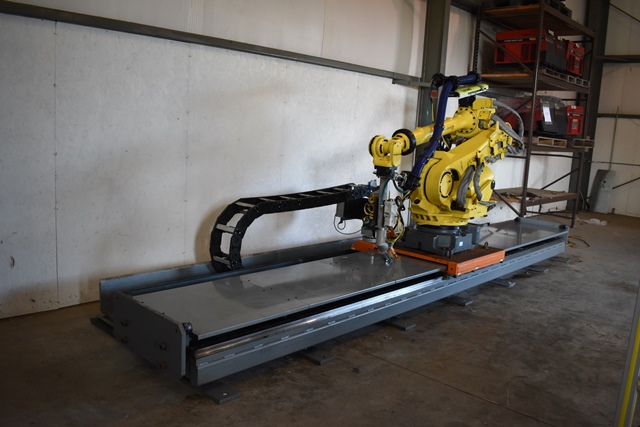Robotic Transfer Units

Robot transfer units, or RTUs, solve one of the main limitations of industrial robots, which is their lack of mobility due to fixed positioning. Industrial robots feature much longer reaches than humans with rotational movement but are unable to move from workstation to workstation. Integrating an industrial robot with an RTU solves this problem by enabling it to move linearly along production floors.
In general, an RTU features a straight track with a platform. An industrial robot is mounted to the platform and the track is then able to move the robot linearly. Most RTUs are floor mounted, but there are options for wall or ceiling mounted RTUs in the form of robotic gantry systems. Floor mounted RTUS often have covers to protect against corrosion and allow workers to walk along the track when maintenance is needed. RTUs provide industrial robots with an extra axis. When a six-axis robot is integrated with an RTU it is referred to as a seven-axis robot. For instance, integrating the FANUC R-2000ib robot with an RTU turns it into a high-DOF robot with an additional seventh axis.
RTUs can range from a few feet long to spanning the entire length of a factory. They give stationary robots the ability to travel along production lines. This reduces the number of robots needed to automate a manufacturing process as one robot can be used to automate multiple steps since it has the ability to travel between workstations. RTUs are ideal for applications involving multiple machines such as automated machine tending and injection molding. They are also beneficial for automating welding, drilling, painting, dispensing, and assembly tasks. Integrating a FANUC M-710ic/50 with an RTU allows it to tend multiple machines instead of needing a designated robot for each machine in a production line.
Benefits of RTUs
Integrating an RTU with an industrial robot can be very beneficial to manufacturing operations, especially if multiple machines are involved or if wanting to fully automate a factory. Some of the main benefits of robots with tracks include:- • Cost-Effective - Opting to integrate your an RTU to an industrial robot is a cost-effective alternative to investing in multiple robots. One Motoman HP20 can tend all machines with an RTU, saving significant costs by decreasing the number of robots needed.
- • Increases Work Envelope - RTUs help expand an industrial robot’s work envelope by enabling it to move linearly. This can be helpful for applications involving large workpieces or those requiring greater distances for travel.
- • Saves Floorspace - In the case of wall or overhead mounted RTUs, floorspace can be saved. Floorspace below the RTU is kept open, allowing for more room for products or other manufacturing equipment.
- • Reduces Cycle Times - RTUs transfer robots quickly between workstations without stopping which can reduce cycle times. RTUs can have speeds of up to three meters per second, allowing robots to travel greater distances in less time.
- • Streamlines Automation - Since RTUs can reduce the number of robots needed to automate a production line, manufacturing becomes more streamlined. Fewer robots are needed for complete robotic automation which reduces costs, maintenance needs, and space requirements for an overall more efficient manufacturing operation.
Robots Done Right is the place to start when it comes to used robots. Contact us if you are interested in buying or selling a used robot.